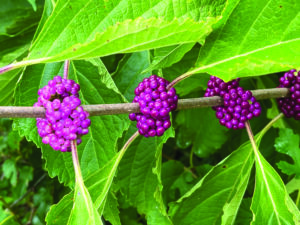
The American Beautyberry’s tiny flowers mature into quarter-inch vibrant glossy bluish-purple berries that also clasp the arching stems in clusters about a half-inch wide, which provide food for many native birds and mammals. (Photo by Ginny Rosenkranz)
American Beautyberry or Callicarpa americana is a wonderful native shrub that greets spring with fragrant, bright green foliage that sit opposite each other on long slender arching stems.
The leaves can grow 3-6 inches long and 1-3 inches wide with a pointed tip and serrated or saw-toothed margins.
In late spring the plants produce tiny clusters of flowers that grow in a circle around the stem and can come in white, pink, lavender or blue in color that are visited by native butterfly pollinators and the Honey bee.
The tiny flowers mature into quarter-inch vibrant glossy bluish-purple berries that also clasp the arching stems in clusters about a half-inch wide, which provide food for many native birds and mammals.
American Beautyberry prefers to grow in full sun or light afternoon shade in organically rich well drained soils.
The plants can grow 3-8 feet tall and 3-6 feet wide, but only flower and bear the glowing berries on new growth. To keep promoting new growth trim about 1/3 of the branches to about 4 inches off the ground is in late winter.
That will insure new flowers and new berries every year.
The glowing purple berries are an important source of food for the American robins, brown thrashers, purple finches, eastern towhee and the bob white. Foxes, opossums, raccoons and squirrels also love to feast on the berries and white-tailed deer browse on the leaves and feast on the berries after the leaves turn a soft chartreuse in color.
There are some American Beautyberry that have glowing white berries like and “Lactea” or “Russell Montgomery” or pink berries on “Welch’s Pink.”
Plant these beautiful shrubs in clusters or as an accent plant in pollinators gardens, children’s gardens and winter gardens where you can enjoy their four seasons of beauty.
(Editor’s Note: Ginny Rosenkranz is a commercial horticulture specialist with the University of Maryland Extension.)



